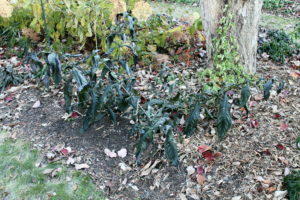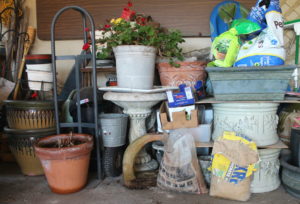Instant Winter: That Happened All of a Sudden!
November 14th, 2017
So we were sailing along almost into mid-November with blooming annuals, ripening peppers and very pleasant 60- and 70-degree days.
Then, wham! Instant winter. Crunchy ground. Forecasts of snow squalls and sleet.
Friday night’s nosedive into record-setting, low-20s territory put a sudden and definite end to the growing season. Some areas had flirted with frost earlier, but there was no doubt about this one.
The end-of-the-season part isn’t unusual. We really should’ve been done two to three weeks ago. The third week of October is the average time of our first fall killing frost.
What’s unusual is how fast the temperature plummeted – from nearly 20 degrees above the daytime norms to nearly 20 degrees below the overnight norms.
I don’t think the sudden shift was enough to do serious damage to landscape plants – other than the annual flowers and tender veggies, which die (and normally so) with a freeze. But we won’t know for sure until next spring when new growth occurs (or not).
According to the National Gardening Association, most winter plant damage happens in late fall to early winter – not during the peak of coldness in January and February.
One reason for that is because plants are more vulnerable to cold injury when they haven’t fully prepared for winter, a process commonly called “hardening off.”
Hardening off happens gradually in fall. Chlorophyll production slows, growth slows, plant cells produce more sugars and proteins that act as anti-freeze to ward off freezing damage, and trees get rid of their water-using leaves (no longer needed when growth is done and soil moisture is locked up in frozen ground anyway).
A severe freeze before the anti-freezing is done can damage buds and branches, while a tree-leaf-freeze before the leaves are ready to drop can lead to damaging moisture loss from the plant.
In a normal fall, temperatures gradually cool as the days grow shorter. Trees and shrubs use those cues to grow “abscission” cells where each leaf stem attaches to branches.
As the leaves grow dormant and change color, abscission cells seal off the attachment and actually “push” the leaves off the tree.
In erratic, sudden freezes, the leaves are killed before that seal finishes, leaving moisture-losing openings when wind blows off the dead leaves. Sometimes those dead leaves can hang on for weeks instead of dropping like they normally would in November – something we could see after this past weekend’s sudden nosedive.
Some plants are more vulnerable to the shock of sudden freezes than others. Other factors include a plant’s health, how far along in the hardening-off process the plant was, and what you and/or the weather did to help or interfere with the process.
There’s not much we can do about wild weather swings, but we can avoid hardening-off “operator errors.”
Two big ones are not pruning and not fertilizing plants with high-nitrogen fertilizers in early fall. Both of those stimulate growth at a time when plants should be heading into dormancy and hardening off.
Before you go into winter dormancy, the weekend’s freeze created some garden jobs that could/should be done.
One is yanking the brown blobs that used to be your annual flowers and warm-weather vegetables. Compost them if they’re not diseased or bug-ridden.
Second, go ahead and cut back perennials or ornamental grasses whose foliage has browned. You don’t have to do this now (end of winter is also fine), but if you’re not a fan of brown foliage or had bugs or disease on some plants, clip them before the snow flies. (Note: mums and borderline-hardy perennials prefer keeping their spent foliage as “insulation blankets” over the winter, so wait until end of March to cut them.)
Third, if you haven’t already done it, get breakables inside for winter storage. That includes terra-cotta and ceramic pots, breakable yard ornaments, fountains, and hoses.
Fourth, cut the lawn short (1 to 2 inches) for the last time of the year. A short cut makes the lawn dry quicker and become less prone to snow-mold damage in late winter and early spring. It is a good idea to fertilize the lawn now one last time with an organic product or one with slow-release nitrogen.
Read George’s PennLive column for more on winter-prepping jobs in the garden.
Read George’s PennLive column on winter-proofing the yard and fertilizing the lawn in fall.
Read George’s PennLive column on more ways to get the yard ready for winter.
Read George’s PennLive column on what we learned from the 2017 growing season.









